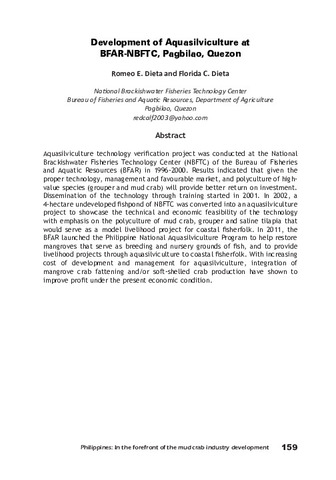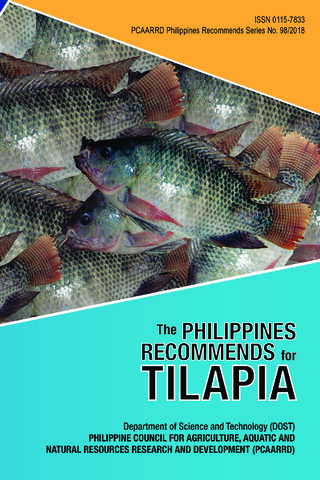Development of aquasilviculture at BFAR-NBFTC, Pagbilao, Quezon
| dc.contributor.author | Dieta, Romeo E. | |
| dc.contributor.author | Dieta, Florida C. | |
| dc.contributor.editor | Quinitio, Emilia T. | |
| dc.contributor.editor | Parado-Estepa, Fe Dolores | |
| dc.contributor.editor | Coloso, Relicardo M. | |
| dc.date.accessioned | 2017-08-25T09:11:32Z | |
| dc.date.accessioned | 2017-08-25T16:35:46Z | |
| dc.date.available | 2017-08-25T09:11:32Z | |
| dc.date.available | 2017-08-25T16:35:46Z | |
| dc.date.issued | 2017 | |
| dc.identifier.citation | Dieta, R. E., & Dieta, F. C. (2017). Development of aquasilviculture at BFAR-NBFTC, Pagbilao, Quezon. In E. T. Quinitio, F. D. Parado-Estepa, & R. M. Coloso (Eds.), Philippines : In the forefront of the mud crab industry development : proceedings of the 1st National Mud Crab Congress, 16-18 November 2015, Iloilo City, Philippines (p. 159). Tigbauan, Iloilo, Philippines: Aquaculture Department, Southeast Asian Fisheries Development Center. | en |
| dc.identifier.isbn | 9789719931072 | |
| dc.identifier.uri | http://hdl.handle.net/10862/3195 | |
| dc.description | Abstract only. | en |
| dc.description.abstract | Aquasilviculture technology verification project was conducted at the National Brackishwater Fisheries Technology Center (NBFTC) of the Bureau of Fisheries and Aquatic Resources (BFAR) in 1996-2000. Results indicated that given the proper technology, management and favourable market, and polyculture of high-value species (grouper (Epinephelus) and mud crab (Scylla)) will provide better return on investment. Dissemination of the technology through training started in 2001. In 2002, a 4-hectare undeveloped fishpond of NBFTC was converted into an aquasilviculture project to showcase the technical and economic feasibility of the technology with emphasis on the polyculture of mud crab, grouper and saline tilapia (Oreochromis) that would serve as a model livelihood project for coastal fisherfolk. In 2011, the BFAR launched the Philippine National Aquasilviculture Program to help restore mangroves that serve as breeding and nursery grounds of fish, and to provide livelihood projects through aquasilviculture to coastal fisherfolk. With increasing cost of development and management for aquasilviculture, integration of mangrove crab fattening and/or soft-shelled crab production have shown to improve profit under the present economic condition. | en |
| dc.language.iso | en | en |
| dc.publisher | Aquaculture Department, Southeast Asian Fisheries Development Center | en |
| dc.subject | Epinephelus | en |
| dc.subject | Oreochromis | en |
| dc.subject | Scylla | en |
| dc.subject | Philippines | en |
| dc.title | Development of aquasilviculture at BFAR-NBFTC, Pagbilao, Quezon | en |
| dc.type | Conference paper | en |
| dc.citation.spage | 159 | |
| dc.citation.conferenceTitle | Philippines : In the forefront of the mud crab industry development : proceedings of the 1st National Mud Crab Congress, 16-18 November 2015, Iloilo City, Philippines | en |
| dc.subject.asfa | aquaculture | en |
| dc.subject.asfa | aquaculture economics | en |
| dc.subject.asfa | commercial species | en |
| dc.subject.asfa | crab culture | en |
| dc.subject.asfa | economic feasibility | en |
| dc.subject.asfa | fish culture | en |
| dc.subject.asfa | fish ponds | en |
| dc.subject.asfa | growing ponds | en |
| dc.subject.asfa | mangroves | en |
| dc.subject.asfa | marketing | en |
| dc.subject.asfa | polyculture (aquaculture) | en |
| dc.subject.asfa | pond culture | en |
| dc.subject.asfa | production management | en |
Files in this item
รายการนี้ปรากฏใน (s)
-
Philippines : In the forefront of the mud crab industry development [44]
Proceedings of the 1st National Mud Crab Congress





